#klondike 1998
Explore tagged Tumblr posts
Text
youtube
Klondike Solitaire is a classic card game that is often associated with the standard solitaire experience. Played with a standard deck of 52 cards, this card game involves arranging and sorting cards into a particular layout to achieve a winning condition.
To begin, the game starts with a tableau made up of seven columns. The first column has one card, the second has two cards, the third has three cards, and so on, until the seventh column, which has seven cards. The top card of each column is face-up, while the remaining cards are face-down. The deck is placed in a draw pile, from which players can draw cards to assist in gameplay.
The objective of Klondike Solitaire is to move all the cards to four foundation piles, each corresponding to one of the four suits: hearts, diamonds, clubs, and spades. These foundation piles need to be built in ascending order from Ace to King.
Gameplay involves several key actions. Players can move cards within the tableau to create descending sequences of alternating colors (for instance, a red 6 can be placed on a black 7). Cards can also be moved to the foundation piles in ascending order within the same suit. The game also allows players to draw cards from the deck, which can be used to either place on the tableau or the foundation piles. Cards from the tableau can be moved to the foundation piles if they match the required rank and suit.
A crucial aspect of Klondike Solitaire is managing the draw pile. Cards from the deck can be drawn one at a time or in groups, depending on the version of the game. If the draw pile is exhausted, the game typically allows players to reshuffle the discarded cards and use them again.
Players need to carefully strategize to uncover hidden cards, build sequences in the tableau, and transfer cards to the foundation piles. The game is won when all cards have been moved to their respective foundation piles in the correct order. If no more moves are possible and the tableau and foundation piles are not yet complete, the game is lost. This solitaire is known for its blend of skill and luck, offering a challenging and engaging experience for players.
#solitaire games#html5 games#browser games#online browser games#browser video games#online solitaire#klondike solitaire#klondike 1998#old gamer#gaming videos#youtube video#longplay#love gaming#gaming life#gamer for ever#gamer for life#gamer guy#gaming community#video games#gaming#Youtube
1 note
·
View note
Text
Alice in Cardland 64
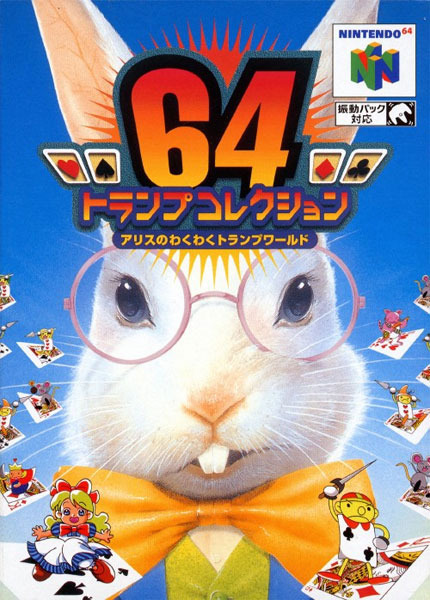
JP release: 7th August 1998
NA release: N/A
PAL release: N/A
Developer: Bottom Up
Publisher: Bottom Up
Original Name: 64 Trump Collection: Alice no Waku Waku Trump World
N64 Magazine Score: 21%

The name “Alice in Cardland” is my attempt at a localised name for this game, the more literal translation is “64 Playng Collection: Alice’s Exciting Playing Card World”. The game is listed online as “64 Trump Collection: Alice no Waku Waku Trump World”, however “Trump” is essentially a Japanese slang term for playing card games (presumably based on “trump card”, used in some trick-taking games).
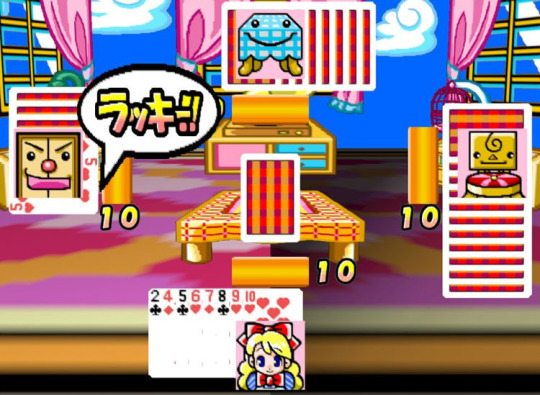
Alice in Cardland is a retelling of Alice in Wonderland where Alice has to win a card game to progress. The first one is Old Maid (played with a joker instead of a queen). The problem with card games like this: you are literally drawing random cards from opponents. There’s no skill. You can protect a card three times in a round, but that’s only useful if you’re losing and the CPU can do the same to you. You have to have the highest store in three rounds, so you just have to keep trying until you randomly win.
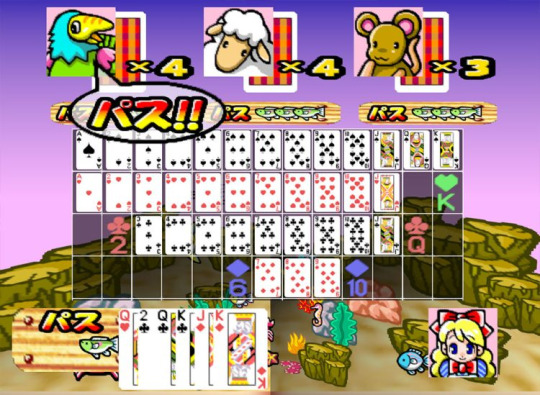
I decided to let Alice spend the rest of her life with the living furniture as you can just play the games separately. The regular card games consist of: Pairs, Old Maid, Sevens, Speed, Cheat/Doubt, Page One (a version of Uno using just playing cards), Daifugō (a Japanese card game where you have to get rid of your cards, a bit like a trick taking game) and Seven Bridge, although there are a few extra games as well.

I was intrigued when I saw poker, but it’s just a very basic Video Poker. Blackjack is also played in the same interface – it all seems like it was taken from another game and thrown into this for more content.
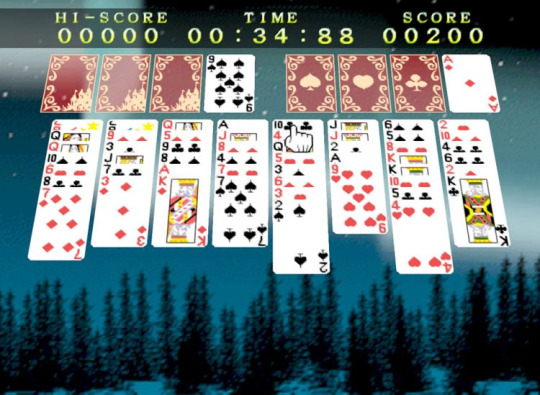
The same is also true of solitaire (Klondike and Freecell variants), which again seems like they’re from a completely different game. Rounding out all the games are a few “fortune telling” events and another Uno variant with slightly different rules.
Alice in Cardland isn’t terribly made, it all works and has a cute style. It’s more the concept of the game that fails. In multiplayer, it’s far less cumbersome to play all these games with a £1 pack of cards. The only advantage is you can play against the computer, but these games are just dull without the conversation and banter – not to mention how you facial expressions and bluffing turn games like Old Maid into an actual game and not just picking random cards.
If, like us, you’ve always found yourself being repeatedly humiliated whenever a deck of cards is present, Trump World will offer you that self-same experience many times over. Card sharks are scuppered, too, because any attempt to read the poker face of a chair, or a mouse, is ultimately destined to fail.
- Mark Green, N64 Magazine #25
Remake or remaster?
A pack of playing cards is the only “remake” needed.
Official ways to get the game.
There is no official way to get Alice in Cardland
7 notes
·
View notes
Text










Skagway, AK (No. 3)
Klondike Gold Rush National Historical Park is a national historical park operated by the National Park Service that seeks to commemorate the Klondike Gold Rush of the late 1890s. Though the gold fields that were the ultimate goal of the stampeders lay in the Yukon Territory, the park comprises staging areas for the trek there and the routes leading in its direction. There are four units, including three in Municipality of Skagway Borough, Alaska and a fourth in the Pioneer Square National Historic District in Seattle, Washington.
A fuller appreciation of the story of the Klondike Gold Rush requires exploration and discovery on both sides of the Canada–United States border. National historic sites in Whitehorse and Dawson City, Yukon, as well as in British Columbia, complete the story. In 1998, Klondike Gold Rush National Historical Park joined with Chilkoot Trail National Historic Site, Dawson Historical Complex National Historic Site, and "The Thirty Mile" stretch of the Yukon River to create Klondike Gold Rush International Historical Park, allowing for an integrated binational experience.
Source: Wikipedia
#Petunia Night Sky#Golden North Hotel#Alaska#travel#original photography#vacation#tourist attraction#landmark#flora#nature#Last Frontier#Alaska Panhandle#Coast Mountains#forest#woods#tree#snow#summer 2023#cityscape#architecture#Skagway#USA#Broadway#Klondike Gold Rush National Historical Park#flower#street scene
3 notes
·
View notes
Text
MOVIES (checklist?)
(and cool youtube videos at bottom)
red = watched
pink = not watched/want to watch
🐝
[SLAVIC FILM]
my thoughts are silent — 2019
donbas — 2018
klondike — 2022
winter on fire — 2015
the voice of grass - 1992
СТАЛКЕР - 1979
come and see — 1985
color of pomegranates - 1969
the cranes are flying — 1957
commissar — 1967
fall of berlin — 1950
decay — 1990
oxygen starvation — 1991
wedding with death — 1992
homecoming — 2013
battle for sevastopol — 2015
offisers — 1971
tangerines — 2013
����
[GERMAN FILM]
im westen nichts neus — 1928
nothing new in the west — 2022
the downfall — 2004
metropolis — 1927
almanya — 2011
the boat — 1981
the fox — 2022
the white ribbon — 2009
run boy run — 2013
the pianist — 2002
run lola run — 1998
🦢
[ENGLISH FILM]
hunt for red october — 1990
fight club — 1999
boy in striped pajamas — 2008
greyhound — 2022
hacksaw ridge — 2016
saving privat ryan — 1998
the godfather — 1972
forrest gump — 1994
american psycho — 2000
casablanca — 1942
apollo 13 — 1995
hidden figures — 2016
rocky 1-6 — 1996 - 2006
creed 1-3 — 2015 - 2023
🦦
[YOUTUBE VIDEOS]
RIOT HOLIDAY
KYIV NIGHTS OF FIRE
SHINING
38 MINUTES. 18 KILLINGS.
WORK LIFE BALANCE
THE WOLF
THE DAY AFTER 9/11
#movies#movie checklist#slavic movies#українські фільми#словʼянські фільми#німецькі фільми#англомовні фільми#російські фільми#ukrainian film#german movies#english movies#checklist#deutsch filme#russische filme#ukrainische filme#englisch filme
1 note
·
View note
Photo

US postage stamp. Scott #3235 (1998) "Klondike Gold Rush" Issued: August 21, 1998 in Nome, AK Quantity: 28,000,000 Printed By: Sterling Sommer for Ashton-Potter (Lithographed) In 1898, the first major discovery of gold near Nome, Alaska, brought nearly 60,000 Americans on a treacherous journey to the Klondike.
#stamp#stamps#stamp collecting#Stamp Collection#Stamp Collector#postage#postage stamps#mail#usps#klondike#gold rush
7 notes
·
View notes
Text
Mario Free Download For Mac

Mario forever free download - Klondike Forever, Solitaire Forever, Euchre Forever, and many more programs. Install and run Mac OS 9.2.1 or 9.2.2 on unsupported OS 9.1 Macs. Free User rating. Super Mario Run Download Free Mario Run game for PC and Mac. Before Shigeru Miyamoto became the father of modern video games, he was just one of the humble developers from Nintendo whose mission is to develop the next big title. His original concept involves the characters from the popular cartoon series called Popeye.
Free Apple Mac Software Downloads
Downloads For Mac
Advertisement
Super Mario Bros. Python v.1.0This is just a Demo release of the game. Known problem: - The game runs slow / laggy. i think the enemies/camera might be causing it. Play as Supermario in 4 new levels! Game made in python with help of sprites/images Made by ...
Super Mario Power Coins v.1.0SuperMario Power Coins - Help Mario catch coins and mushrooms in this online mario game. Press 'JUGAR' to ...
Secret Maryo Chronicles v.1.0A Jump and Run game like SuperMario World with an advanced Editor and highly detailed Graphics based on SDL with a OpenGL accelerated Graphics Renderer developed in C++. Runs under Linux, Windows and Mac and can be easily ported to other ...
JMario v.0.8.1JMario is a side-scroll game, built in Java, based on Nintendo's SuperMario World. It's been developed by David Buzatto as part of his course conclusion work entitled 'Utilization of Java Platform for 2D Game Development'.
Spontane v.0.1Spontane is a 2d fast-paced fighting game, for play on your local computer, LAN, or Internet, on any OS which runs Java. Similar to Nintendo's Super Smash ...
Brave Dwarves Back for Treasures (Mac) v.1.01Join the brave dwarves, a Wizard and a Warrior, to collect treasure and vanquish enemies in magic lands! Travel through 100 fantastic levels and explore the subterranean world that has been taken over by evil.
Jig_nintendo02-nintendo v.0001Nintendo? were going to take a deep look at the Wii hardware and a few of the launch games and see if the Nintendos . when i look back on my review of the Nintendo Wii and a few other comments i a chance to buy Nintendos system the demand has fully o ...
Pingus for Mac OS v.0.7.2_2Has started at the end of 1998 with the simple goal to create a Free (as in freedom, not as in free beer) Lemmings clone. The Free means you get the sources and are allowed and encouraged to change and distribute them. You basically get everything ...
Super Mega Blackjack Supreme for Mac OS v.1.1Place your bets in the best Blackjack game ever! Double down, split, or take a hit and earn a seat at the golden High Rollers Table!Super Mega Blackjack Supreme is the ultimate blackjack experience. Unlike other blackjack games, Super Mega ...
Download super mario war mac os for free. Games downloads - Super Mario War by 72dpiarmy and many more programs are available for instant and free download.
Mario free download - Barney, Coda PHP & Web Toolkit, Safari Omnikey, and many more programs.
Wheel of Fortune Super Deluxe for Mac OS v.1.0Spin the Wheel, call a letter, buy a vowel and solve the puzzle! This super-sized version of Wheel of Fortune Super Deluxe is packed with more puzzles and excitement than ever before! Players can go head to head with a friend or compete against the ...
Super Mega Sudoku for Mac OS v.1.2Play Classic, Battle, and Challenge Sudoku all in one!Super Mega Sudoku upgrades sudoku to the next level. Not only enjoy classic sudoku fun, but add a new twist with both Battle Sudoku and Challenge modes! Take on the Master’s assistant in ...
Jeopardy! Super Deluxe for Mac OS v.1.0Test your knowledge with this super-sized version of the Jeopardy! Mac Game! Quiz yourself or challenge the computer’s contestants for control of the board. Lightning fast skills, correct responses and wise wagers will give you the lead.
Super Collapse! Puzzle Gallery 4 for Mac OS v.1.0The brain-bending fun continues in this addition to the hugely popular, and super addictive, series of puzzle games. Click colorful blocks to clear them from the screen in over 300 all-new puzzles - each one an original image that was cleverly ...
Super Laser Racer for Mac OS v.1.01Blast your way through outer geometric space in this entirely new style of racing! Super Laser Racer is like nothing youve played before! - Added Polish and Portuguese languages.
Super PhotoCut Pro for Mac v.2.7.0Super PhotoCut Pro professionally focuses on wedding dresses & transparent object Masking. It instantly cut out wedding dresses from complex image backgrounds without any loss of image quality on Mac in seconds-to-minutes instead of minutes-to-hours.
AV Bros. Page Curl for Mac OS X v.2.0AV Bros. Page Curl 2.0 is a high quality, powerful and easy-to-use Photoshop plugin (Photoshop plugin means the filter plugin (8bf) for Adobe Photoshop and compatible hosts.) for creating the very realistic turning and folding page effects.
AV Bros. Puzzle Pro for Mac OS X v.2.0AV Bros. Puzzle Pro 2.0 is an extremely powerful and flexible Photoshop plugin (Photoshop plugin means the filter plugin (8bf) for Adobe Photoshop and compatible hosts.) for creating jigsaw puzzle effects of various types.
Mario Online v.1.0Mario Online is a game in which you control a moustached plumber with a glorious name, Mario. This time neither evil Bowser nor his companion, wizard Kamek, are plotting some vile plan. It is Mario, all alone, who makes a time tournament, he took a ...
Super AVI to DVD v.2.7.43Super AVI to DVD Converter is a professional and easy-to-use AVI to DVD Software, easy convert AVI file to MPG, MPEG, WMV, MP4, 3GP, MOV, RM, VCD, DVD, SVCD, MPEG1/2/4 iPod, Zune, PSP, iPhone ...
Super BlackBerry Video Converter + DVD to BlackBerry Suite v.2.7.23Super BlackBerry Video Converter + DVD to BlackBerry Suite is a One-click, All-in-One solution to create BlackBerry movies from DVDs, TV shows and home videos. The software combines DVD to BlackBerry Converter and BlackBerry Video Converter in one ...

Super Mario Bros software by TitlePopularityFreewareLinuxMac

Free Apple Mac Software Downloads
Today's Top Ten Downloads for Super Mario Bros
Super Vectorizer 2 for Mac Super Vectorizer 2 for Mac is a professional vector trace
Super CD Converter Super CD Converter is a powerful audio CD ripper, CD to
Super Gerball for Mac OS Gerry the gerbil loves playing in his ball - he would play
Super Denoising for Mac Super Denoising for Mac is a photo noise reduction
Wheel of Fortune Super Deluxe for Mac OS Spin the Wheel, call a letter, buy a vowel and solve the
Super Bounce Out Super Bounce Out 1.0.2 is a hot game which will attract
Super PhotoCut Pro for Mac Super PhotoCut Pro professionally focuses on wedding
Super Audio Ripper + MP3 Converter Suite Audio Ripper + MP3 Converter Suite is the perfect software
Super Mario Power Coins Super Mario Power Coins - Help Mario catch coins and
AV Bros. Page Curl for Mac OS X AV Bros . Page Curl 2.0 is a high quality, powerful and
Downloads For Mac
Visit HotFiles@Winsite for more of the top downloads here at WinSite!

1 note
·
View note
Text
FEMALE RAPPERS: TAURUS
BAHAMADIA (22-04-1966)

MILLIE B (24-04-2001)

TIONNE WATKINS (26-04-1970)

LIZZO (27-04-1988)

KLONDIKE BLONDE (28-04-1997)

MIMI (01-05-1995)

RICO NASTY (07-05-1997)

COI LERAY (11-05-1997)

CUBAN DOLL (12-05-1998)

DIAMOND (20-05-1988)

* images aren't mine, credits to the owners *
#female rapper#zodiac signs#aries#taurus#gemini#cancer#leo#virgo#libra#scorpio#sagittarius#capricorn#aquarius#pisces#bahamadia#millie b#tionne watkins#lizzo#rico nasty#diamond#cuban doll#coi leray#mimi#oh my girl#klondike blonde
77 notes
·
View notes
Text
Uncharted #1 - Solitaire (Microsoft, Windows, 1990)
[Uncharted is an occasional feature where I look at games which were massively successful but, for whatever reason, were not eligible for the charts so could not possibly have made my list of #1 games. In this case it is because Solitaire was part of Windows rather than sold separately]
[Note that this post originally appeared without this intro on April Fool’s Day]
In tribute to 1990’s biggest game and a titan of gaming, here is an entire deck of facts about Microsoft’s Solitaire:

1. Solitaire has been available for every release of Windows since Windows 3.0. 2. On Windows 8 it wasn’t pre-installed, though. Boo. 3. Solitaire is based on a real-life card game which may or may not have been played by Napoleon to pass his time in exile, in much the same way as the modern version has long served office workers. 4. Solitaire was considered a good way to teach mouse movement, drag-and-drop etc. to those who hadn't already been doing that on their Amigas or Atari STs for years. 5. Solitaire was programmed by Microsoft intern Wes Cherry. He was never paid for his efforts. 6. Linux users desperate to play Solitaire have been able to do so since the 1993 introduction of Wine (which stands for Wine Is Not an Emulator). 7. You can play Solitaire on iOS and Android mobile devices too these days, so no need to confine your distraction to desk-based times only. 8. And you can play it in Google by typing Solitaire into the search, and all. No word on if they’ll be bringing in seamless live-streaming for it yet. 9. The modern Windows version of Solitaire contains adverts which can only be removed by paying a subscription, showing how perfectly it has adapted to the current environment. 10. Solitaire was at one point the single most-used Windows application in the world. 11. The original version of Solitaire allows players to switch between Vegas and Standard scoring systems, or to free themselves from the restrictive concept of ‘points’ altogether. 12. Economists believe that Solitaire was responsible for the US recession of 1990-1991. 13. The verified speedrun record for Solitaire is 5 seconds.

14. Tool assisted speedruns have brought times down to as low as 3 seconds. 15. Speedrunners have determined that switching the game language to German allows for the fastest possible time. 16. The top professional Solitaire players regularly earn £200,000 a year in prize money. 17. The highest score you can earn in the standard version of Solitaire is 24,113. 18. 0.25% of possible Solitaire games are impossible to solve. 19. Dr. Maressa Hecht Orzack of Harvard Medical School opened the first clinic for computer addiction in 1996 after becoming obsessed with her Solitaire high score. 20. In 2006, a worker for the city of New York was fired after the city’s mayor saw Solitaire on their computer screen at work. 21. A study by Dr. Jeffrey Goldstein at the University of Utrecht found that being allowed to play Solitaire at work improved employees’ productivity and job satisfaction. 22. Solitaire was the first computer game to be played aboard the International Space Station. 23. Microsoft celebrated Solitaire's 25th anniversary by holding a tournament that saw the company’s strongest players play against fans. 24. Also to coincide with the 25th anniversary: the release of a set of physical playing cards based on Susan Kare’s initial Solitaire designs. 25. In the US, the 22nd of May each year is officially Solitaire Day. 26. The rest of the world prefers to celebrate Solitaire Day on the 1st of May.

27. In 1998, the billionth game of Solitaire to be played was celebrated with a special presentation at that year’s Solicon. 28. In 2017, Microsoft reversed plans to remove Solitaire from Windows 10 completely, after an outpouring of despair from users at the prospect of it being replaced by Solitaire 3D. 29. Under the right conditions, it is possible to complete a round of Solitaire with only half a left click. 30. Some versions of the game Doom secretly contain a complete, playable version of Solitaire within their code. 31. Solitaire was devised partly as a way of paying tribute to the origins of Microsoft, which was founded in 1889 as a playing card company. 32. Wes Cherry went on to develop a hat-themed sequel, Hataire. It was significantly less successful. 33. Solitaire succeeded despite an initial protest campaign of negative reviews, organised by a group of male gamers upset at what they perceived to be an unrealistic proportion of female characters among the most powerful cards. 34. While there is a buzzing scene of retrogamers playing Solitaire on emulators, some purists consider that it is only worth playing on an original IBM PS/1. 35. The IBN 0401 would be an acceptable alternative were they not all in the ownership of hackers and time travellers. 36. An alternative ending in which all of the cards die was removed as ‘too depressing’, leaving the famous cascade. 37. Hackers have determined that there is a Solitaire stage as part of forthcoming Super Smash Bros. Ultimate downloadable content, leading to speculation on whether the robot from the back of the cards will be included as a fighter. 38. The order of the twelve card backs, with the patterns first and the dressing gown aces last, was determined by the order in which each of them completed a race across a river. 39. The bright beach scene card back was inspired by the meaning of the Latin root of the name Solitaire, ‘the sun is the air’.

40. In addition to the standard card backs, it is rumoured that a cursed thirteenth may appear at midnight on rainy days. 41. If you put your nose right up to one of the patterned card backs, focus as though you are looking through the image into the distance, and very slowly move your face away from the image, you will see a blurry pattern on the back of a card. 42. Variations of the original card game include Spider Solitaire, Klondike Solitaire, Clock Solitaire, and Hexadecimal Solitaire. 43. Factional disagreements between Klondike and Spider loyalists culminated in the 2004 Solitaire War, since when neither side acknowledges the other’s legitimacy. 44. A reference to this dispute appears in Kanye West’s 2007 single “Stronger”. 45. Other musicians to have paid tribute to Solitaire include Chris Webby, Gucci Mane and Neil Sedaka. 46. Microsoft are believed to be currently developing a battle royale version of Solitaire. 47. The forthcoming battle royale version would be the first new entry in the mainline Solitaire series since Solitaire Remix Card Capture Current (Dub Edition). 48. Once there were the cards, and when all else is dust, again shall there be the cards. 49. Solitaire is banned in Belgium. 50. Solitaire having been a UK chart #1 is as real as around half of these facts. Solitaire didn’t make it to the top of the chart, because no one went out to the shops to buy a cassette or disk version of it. 51. It was, though, more widely played in the UK than most (all?) of the games which I am covering around it, and in its own way did as much or more for gaming. The niche of semi-attention-occupying pastime played on devices lots of people were already using for other reasons was to be an exceptionally fruitful one. 52. The particular form of this entry was inspired by an irresistible scheduling coincidence placing it on 1 April, but I do genuinely want to give some attention to games which have made a massive impact without their popularity being in a form that the charts recognise. As such, this is going to be the first of an irregular series doing just that, each time I reach one of those games in my timeline. The series will be called Uncharted. And it’s only a week until I get to its second entry.
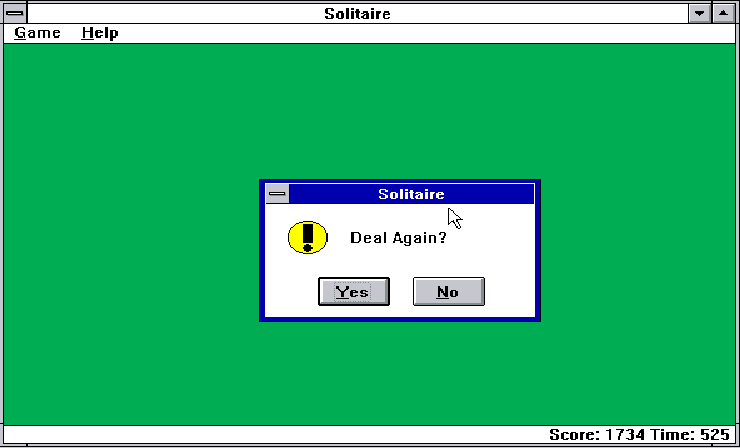
24 notes
·
View notes
Photo

USPS 1998 American Commemorative Panels KLONDIKE GOLD RUSH https://ift.tt/3dDvoyv
0 notes
Photo

The Genesis of Our Lives presents: Mega Man: The Wily Wars - Mega Man 1 run!
Release date: December 31st, 1994
I've been looking for a good excuse to talk about the SEGA Channel.
These days, we don't bat an eye at the idea of getting games online - heck, for a good chunk of games, including almost all indies, that's the only way to get them. Getting games online dates as far back as the 16-bit era, and Nintendo and SEGA both had their own ways of doing it. SEGA's, though, was one that got to the States. While the Super Famicom had the Satellaview service that broadcasted game data like TV channels, we got our games over cable, via the SEGA Channel.
(pfft, I say “we” like I ever had one of those)
SEGA Channel was a subscription service, where you connected an adapter cartridge to a coaxial cable and could download games to play, the selection of which frequently changed but there were usually around fifty at any given time. Like the modern day, several selections were also retail titles, if paired down a little to meet size restrictions. A lot of content was exclusive to the Channel, and included not only full games, such as Klondike, but also some of the first instances of DLC for pre-existing games. Along with games, it also showed special promotions, as well as tips and cheats. The service was released in several other countries, but the United States version overshadowed them all with its high popularity. It continued until late June 1998, when the satellite that broadcasted the data to all the cable stations that provided the service started to fail, eventually falling out of geostationary orbit and drifting off into the cosmos.
Unfortunately, there were two main issues with the service. First was that it launched late in the Genesis' life - it didn't get an official launch until December 1994, leading to complaints regarding paying $13 a month for games on a dying console - for a point of comparison, the 32X released a month earlier. There were apparently plans for a Saturn take on it, but it never materialized. The second was that the games were saved only to RAM, and thus they could never be permanently saved in any form, vanishing into the ether when the console lost power. A large chunk of titles that were exclusive to the service thus become forever lost media when the service closed.
Thank god for Europe, as many games that were released exclusively on SEGA Channel in the States were, either instead or as well, put to cartridge there. I'll be pointing these out as they come along. Today, we'll be starting on one of the most famous SEGA Channel titles - a compiled rerelease of the first three Mega Man games, along with a whole new exclusive set of levels known as "Wily Tower."
Due to the fact that this game is literally three and a half games or so in one package, we'll be taking them on like Wreck-It Ralph: one game at a time. We'll be starting off from the very beginning.
Ready?
Tomorrow at 2 PM Pacific / 5 PM Eastern!
0 notes
Text
Trip to Dawson City
One reason that I put off writing my blogs for a while was the feeling that I needed to try and succinctly and accurately summarize some of the history of the places that I have been visiting. It’s all really interesting, and I’ve enjoyed learning about it, but it’s a bit overwhelming to summarize! Feel free to read up on more of these topics yourself and though I assume that my summary is technically accurate, don’t necessarily take all of this as given truth.
Some background information: The Klondike goldrush refers to the period in time when an estimated 100,000 prospectors (referred to as stampeders) migrated to the Yukon in their search of gold between the periods of 1896 to 1899. Dawson city was the center of the Klondike Goldrush in 1897 and the territorial capital. Most stampeders accessed the Yukon through the ports of Skagway and Deyea in Southern Alaska (I have also been to both of these places now!) where they would then have the choice of taking either the Chilkoot, or Whitepass Trail before sailing up the Yukon river to reach the Klondike Goldfields. During the Klondike goldrush boom towns sprung up across the territories to accommodate the stampeders. Dawson city was founded and named in 1897. Dawson experienced a huge population boom and bust as a result of the goldrush; by the time that the goldrush had ended in 1899, around 32,000 people had migrated out of Dawson and the financial situation that resulted was so dire that in 1953 Whitehorse was named as the new capital city of the Yukon.
The history of this area also extends far back in time before the gold rush. Dawson is located on the traditional territory of the Tr’ondëk Hwëch’in (say tronedeck-witchen) First Nations. The Tr’ondëk Hwëch’in had been living along the Yukon River for many thousands of years prior to the arrival of the settlers. They made their living off the land harvesting salmon from the Yukon river, caribou from the Fortymile and Porcuine Caribou herds (this is the caribou herd that was documented in “finding caribou”), moose and berries were also an important source of food in their diet. The Tr’ondëk Hwëch’in had had contact with European missionaries and fur traders since the mid 19th century, where they were using a combination of traditional and aquired materials, skills and goods to assist and live alongside the newcomers, however when gold was discovered at a site called Tr'ochëk, a seasonal summer camp that had been used by the Tr’ondëk Hwëch’in for hundreds of years, the widely respected leader of the Tr’ondëk Hwëch’in, Sir Chief Isaac, realised the impact that the newcomers could have on his people and he relocated his community to another settlement 5km downriver called Moosehide. The Tr’ondëk Hwëch’in started negogiating their land claims in 1991, and the agreement, which I do not yet completely understand, came into effect in 1998.
1 note
·
View note
Text
Las Vegas, Nevada
The Las Vegas Strip is a stretch of South Las Vegas Boulevard in Clark County, Nevada that is known for its concentration of resort hotels and casinos. The Strip is approximately 4.2 miles (6.8 km) in length,located immediately south of the Las Vegas city limits in the unincorporated towns of Paradise and Winchester. However, the Strip is often referred to as being in Las Vegas. Many of the largest hotel, casino, and resort properties in the world are located on the Las Vegas Strip. The road’s cityscape is highlighted by its use of contemporary architecture, lights and wide variety of attractions. Its hotels, casinos, restaurants, residential high-rises, entertainment offerings, and skyline have established the Las Vegas Strip as one of the most popular and iconic tourist destinations in the United States, and the world. Most of the Strip has also been designated an All-American Road,and is considered a scenic route at night. Historically, the casinos that were not in Downtown Las Vegas along Fremont Street were limited to outside the city limits on Las Vegas Boulevard. In 1959, the Welcome to Fabulous Las Vegas sign was constructed exactly 4.5 miles (7.2 km) outside the city limits. The sign is today located in the median just south of Russell Road, across from the now-demolished Klondike Hotel & Casino, about 0.4 miles (0.64 km) south of the southernmost entrance to Mandalay Bay (the southernmost casino). In the strictest sense, "the Strip" refers only to the stretch of Las Vegas Boulevard that is roughly between Sahara Avenue and Russell Road, a distance of 4.2 miles (6.8 km). However, the term is often used to refer not only to the road but also to the various casinos and resorts that line the road, and even to properties that are not on the road but in proximity. Phrases such as Strip Area, Resort Corridor or Resort District are sometimes used to indicate a larger geographical area, including properties 1 mile (1.6 km) or more away from Las Vegas Boulevard, such as the Hard Rock, Rio, Palms, and Hooters casinos. A long-standing definition considers the Strip’s northern terminus as the SLS, though travel guides typically extend it to include the Stratosphere, 0.4 miles (0.64 km) to the north. Mandalay Bay, located just north of Russell Road, is the southernmost resort considered to be on the Strip (the Klondike was the southernmost until 2006, when it was closed, although it was not included in Las Vegas Strip on some definitions and travel guides). Because of the number and size of the resorts, the Resort Corridor can be quite wide. Interstate 15 runs roughly parallel and 0.5 to 0.8 miles (0.80 to 1.29 km) to the west of Las Vegas Boulevard for the entire length of the Strip. Paradise Road runs to the east in a similar fashion, and ends at St. Louis Avenue. The eastern side of the Strip is bounded by McCarran International Airport south of Tropicana Avenue. North of this point, the Resort Corridor can be considered to extend as far east as Paradise Road, although some consider Koval Lane as a less inclusive boundary. Interstate 15 is sometimes considered the western edge of the Resort Corridor from Interstate 215 to Spring Mountain Road. North of this point, Industrial Road serves as the western edge. Newer resorts such as South Point and the M Resort are on Las Vegas Boulevard South as distant as 8 miles south of the "Welcome to Fabulous Las Vegas" sign. Marketing for these casinos usually states that they are on southern Las Vegas Boulevard and not "Strip" properties. The first casino to be built on Highway 91 was the Pair-o-Dice Club in 1931, but the first on what is currently the Strip was the El Rancho Vegas, opening on April 3, 1941, with 63 rooms. That casino stood for almost 20 years before being destroyed by a fire in 1960. Its success spawned a second hotel on what would become the Strip, the Hotel Last Frontier, in 1942. Organized crime figures such as New York’s Bugsy Siegel took interest in the growing gaming center leading to other resorts such as the Flamingo, which opened in 1946, and the Desert Inn, which opened in 1950. The funding for many projects was provided through the American National Insurance Company, which was based in the then notorious gambling empire of Galveston, Texas.
The Strip in the 1940s. Pictured is the gas station of the Hotel Last Frontier, the second hotel on the Strip. Las Vegas Boulevard South was previously called Arrowhead Highway, or Los Angeles Highway. The Strip was named by Los Angeles police officer and businessman Guy McAfee, after his hometown’s Sunset Strip. Caesars Palace was established in 1966. In 1968, Kirk Kerkorian purchased the Flamingo and hired Sahara Hotels Vice President Alex Shoofey as President. Alex Shoofey brought along 33 of Sahara’s top executives. The Flamingo was used to train future employees of the International Hotel, which was under construction. Opening in 1969, the International Hotel, with 1,512 rooms, began the era of mega-resorts. The International is known as Westgate Las Vegas today. The first MGM Grand Hotel and Casino, also a Kerkorian property, opened in 1973 with 2,084 rooms. At the time, this was one of the largest hotels in the world by number of rooms. The Rossiya Hotel built in 1967 in Moscow, for instance, had 3,200 rooms; however, most of the rooms in the Rossiya Hotel were single rooms of 118 sq. ft (roughly 1/4 size of a standard room at the MGM Grand Resort). On November 21, 1980, the MGM Grand suffered the worst resort fire in the history of Las Vegas as a result of electrical problems, killing 87 people. It reopened eight months later. In 1986, Kerkorian sold the MGM Grand to Bally Manufacturing, and it was renamed Bally’s. The Wet ‘n Wild water park opened in 1985 and was located on the south side of the Sahara hotel. The park closed at the end of the 2004 season and was later demolished. The opening of The Mirage in 1989 set a new level to the Las Vegas experience, as smaller hotels and casinos made way for the larger mega-resorts. The Rio and the Excalibur opened in 1990. These huge facilities offer entertainment and dining options, as well as gambling and lodging. This change affected the smaller, well-known and now historic hotels and casinos, like The Dunes, The Sands, the Stardust, and the Sahara. The lights along the Strip have been dimmed in a sign of respect to six performers and one other major Las Vegas figure upon their deaths. They are Elvis Presley (1977), Sammy Davis Jr. (1990), Dean Martin (1995), George Burns (1996), Frank Sinatra (1998), former UNLV basketball head coach Jerry Tarkanian (2015), and Don Rickles (2017). The Strip lights were dimmed later in 2017 as a memorial to victims of a mass shooting at a concert held adjacent to the Strip.[15] In 2005, Clark County renamed a section of Industrial Road (south of Twain Avenue) as Dean Martin Drive, also as a tribute to the famous Rat Pack singer, actor, and frequent Las Vegas entertainer. In an effort to attract families, resorts offered more attractions geared toward youth, but had limited success. The (current) MGM Grand opened in 1993 with MGM Grand Adventures Theme Park, but the park closed in 2000 due to lack of interest. Similarly, in 2003 Treasure Island closed its own video arcade and abandoned the previous pirate theme, adopting the new ti name. In addition to the large hotels, casinos and resorts, the Strip is home to a few smaller casinos and other attractions, such as M&M World, Adventuredome and the Fashion Show Mall. Starting in the mid-1990s, the Strip became a popular New Year’s Eve celebration destination. Recent years (2000–present)
Four-segment panorama of The Cosmopolitan, Bellagio, and Caesars Palace (left to right) from the Las Vegas Strip, across from the Bellagio fountains.
Gondolas outside of The Venetian. With the opening of Bellagio, Venetian, Palazzo, Wynn and Encore resorts, the strip trended towards the luxurious high end segment through most of the 2000s, while some older resorts added major expansions and renovations, including some de-theming of the earlier themed hotels. High end dining, specialty retail, spas and nightclubs increasingly became options for visitors in addition to gambling at most Strip resorts. There was also a trend towards expensive residential condo units on the strip. In 2004, MGM Mirage announced plans for CityCenter, a 66-acre (27 ha), $7 billion multi-use project on the site of the Boardwalk hotel and adjoining land. It consists of hotel, casino, condo, retail, art, business and other uses on the site. City Center is currently the largest such complex in the world. Construction began in April 2006, with most elements of the project opened in late 2009. Also in 2006, the Las Vegas Strip lost its longtime status as the world’s highest-grossing gambling center, falling to second place behind Macau. In 2012, the High Roller Ferris wheel and a retail district called The LINQ Promenade broke ground, in an attempt to diversify attractions beyond that of casino resorts. Renovations and rebrandings such as The Cromwell Las Vegas and the SLS Las Vegas continued to transform The Strip in 2014. The Las Vegas Festival Grounds opened in 2015. In 2016, the T-Mobile Arena, The Park, the Lucky Dragon Hotel and Casino, and the Park Theatre opened. Smaller changes and developments are taking place as well. On October 1, 2017, a mass shooting occurred on the Strip at the Route 91 Harvest country music festival, adjacent to the Mandalay Bay hotel. This incident became the deadliest mass shooting in modern United States history.
Posted by Aram G. on 2017-11-18 02:16:25
Tagged: , las , vegas , strip , lights , paris , lasvegas , nevada , colors , ballys , blue , red , long , exposures , longexposures , night , urban , architecture , Boulevard , hotel , casino , Paradise , resort , cars , scenic , Downtown , District , Kirk , Kerkorian , growing , gaming , cente , attractions , Street , Fremont , travel , Fabulous , sign , properties , Highway , 91 , Dice , Club , rooms , Organized , crime , Bugsy , Siegel , International Hotel , largest hotels , Rat Pack , gambling , lodging , room
The post Las Vegas, Nevada appeared first on Good Info.
0 notes
Text
Quinzaines, Que trouve-t-on dans Kerouac quand on l’ouvre ?, le 15 juillet 2019
Que trouve-t-on dans Kerouac quand on l’ouvre ?
Carolyn Robinson – « Camille » dans Sur la route de Jack Kerouac
Jack Kerouac, que rendrait célèbre la publication en 1957 de On the Road (Sur la route), un récit qu’il avait terminé d’écrire six ans auparavant, était déjà depuis une dizaine d’années un excellent écrivain, s’étant essayé avec brio, dès son adolescence, à différents styles d’écriture. Seul handicap dans son jeune âge, qu’il ait pris pour modèles qu’il entendait égaler, des auteurs dont le talent de romancier s’identifiait au récit autobiographique.
Le jeune Kerouac des années d’avant-guerre veut raconter la vie, son drame est de ne pas encore avoir vécu. Il écrit ainsi, alors qu’il a vingt ans : « cherchant désespérément à devenir un exilé amer et désespéré ». Ce qu’il est alors encore loin d’être, même si son bref passage dans la marine de guerre lui offrirait quelques semblants d’aventures : il sera réformé pour « tempérament indifférent », sous-entendu « à la machine militaire ».
Pour Jack London, l’aventure ce serait le Klondike de la ruée vers l’or, le front de la guerre russo-japonaise et les mers du Sud. Pour Kerouac, ce serait la route entre sa ville natale de Lowell au nord de Boston et San Francisco, puis entre San Francisco et Mexico City.
À dix-neuf ans, dans un poème en prose intitulé « This I do know », il mentionne dans la liste de ses « voici ce que je sais en tout cas » : « Que je serai influencé par Wolfe, Saroyan, Halper, Withman, et Joyce dans mes écrits ».
Albert Halper (1904-1984) se détache dans la liste pour être aujourd’hui inconnu : tous ses ouvrages sont épuisés, aucun n’a jamais été traduit en français. Sa réputation lui venait d’un recueil de nouvelles en 1934, intitulé On the Shore (le rivage en question étant celui du lac Michigan) et sous-titré « Young Writer Remembering Chicago » : un jeune écrivain se souvient de Chicago. « Young writer », une expression que Kerouac reprendrait à son compte. Emprunt notable à Halper, de l’auteur de On the Road, un titre en écho certainement à On the Shore, l’irruption dérangeante d’expressions argotiques au sein de phrases de facture sinon classique. Halper s’en était justifié dans le chapitre dont l’intitulé était précisément celui du sous-titre de On the Shore, d’un jeune auteur qui se souvient :
… des gens diront : ‘Trop cru et trop gauche, trop bâclé et argotique’. Mais je suis né dans une ville crue et argotique, dans un quartier cru et argotique. […] Essayez donc d’écrire dans la tradition classique avec une telle puanteur dans les trous de nez, posez-vous et tissez donc de suaves phrases poétiques avec le rugissement du chemin fer dans vos oreilles.
Difficulté cependant pour le routard par vocation littéraire que sera Kerouac : ses aventures n’étant pas à la hauteur de ses espérances, ne sont automatiquement pas non plus à la hauteur des nôtres. Car peu importe finalement que cette suite de beuveries, de partouzes, de séances de piquouses, se déroulent à San Francisco, à Denver, Colorado ou où que ce soit d’autre puisque l’âme de la ville en est aussi absente que la personne même des femmes qui hantent le récit comme des spectres, leur nom aux unes et aux autres ne faisant office là que de simple signet : la marque d’un vide, là où nous espérions une identité de chair et de sang.
En 2012, Walter Salles, que nous avions chéri dans Centro do Brasil (1998) – récit de la rédemption d’une vieille vache, mit en scène Sur la route, dont l’opinion commune est qu’il échoua à capturer l’esprit du livre malgré une bonne volonté consciencieuse à coller aux péripéties dont le roman fait l’inventaire. L’originalité du film, la critique l’a relevé, a été de donner vie aux deux épouses de Neal Cassady, personnage central de Sur la route sous le nom de « Dean Moriarty », et il y a peut-être paradoxalement là l’une des raisons de l’échec du film car il n’y a pas place en réalité dans ce récit pour quoi que ce soit d’autre que l’admiration mutuelle que se portent Sol Paradise (le pseudo dont s’affuble Kerouac) et Neal Cassady, son Moi-idéal. Les femmes, « Marylou », de son vrai nom LuAnne Henderson, première épouse Cassady et « Camille », Carolyn Robinson, seconde du nom, ne sont là que comme deux silhouettes en contre-plaqué. Cette dernière reprochera au film de Salles son mauvais choix d’acteurs : Jack et Neal étaient des sportifs baraqués, dira-t-elle, et les acteurs choisis pour les incarner, « des mauviettes ».
L’échec du film de Salles aura eu le mérite de souligner que d’histoire, il n’y en a guère dans Sur la route, et que l’essence de ce récit épique, c’est son rythme échevelé, ce « Go ! Go ! Go ! » qui fut le mot d’ordre de la Beat Generation, dont Kerouac avait saisi qu’il était la valeur ajoutée de son texte, se faisant un point d’honneur de le taper tout entier sur un rouleau pour téléscripteur.
Dans un entretien qu’il accorde un an avant sa mort, qui sera due à la cirrhose, alors que sa femme Stella refuse d’abord d’ouvrir la porte à trois visiteurs inopinés (dont l’un est à son insu Aram Saroyan, fils de William, l’une de ses idoles), de peur que son poivrot d’époux n’y trouve prétexte à une nouvelle cuite, il dira à propos de sa propre écriture :
… elle cherchait à cliqueter tout du long comme une machine à vapeur tirant un train de marchandises de cent wagons et un fourgon qui jacasse tout au bout. Ça c’était ma manière à l’époque et il y a encore moyen de faire ça si la pensée qui se déroule en parallèle à une écriture ardente comme celle-là est sur le mode de la confession, si elle est pure, et toute frétillante de la vie qui l’imprègne.
Or cela, sa « manière à l’époque », n’est pas son invention à lui :
J’ai eu l’idée de ce style spontané de Sur la route en voyant comment ce bon vieux Neal Cassady rédigeait les lettres qu’il m’adressait, toutes à la première personne, haletantes, dingues, sur le mode de la confession, sérieuses comme pas deux, avec une infinité de détails.
Une admiration telle que Jack reprit sans attribution des passages entiers de lettres que lui adressait Neal, le complice de ses chevauchées fantastiques.
Kerouac s’illusionnait quand il pensait que ce qui lui faisait défaut dans ses jeunes années, ce n’était pas le rythme mais le sentiment. Il écrivait ainsi :
J’ai passé toute ma jeunesse à écrire lentement avec des révisions et une rumination interminable qui rabâchait et raturait, si bien que j’écrivais une phrase par jour et cette phrase manquait de SENTIMENT. Le SENTIMENT, nom de dieu, c’est ça que j’aime dans l’art, pas l’ARTISANAT et la dissimulation des sentiments.
Ce sentiment qui lui fait défaut, Kerouac le trouvera tout entier chez Cassady. Mais il échouera à se l’approprier : à lui, il demeurera toujours étranger et il baissera avec précipitation le rideau de fer de l’ivresse chaque fois que la passion fera mine de prendre possession de lui. Il aspire à être le clone de Cassady, un homme dont le tréfonds est de se perdre dans et avec les femmes, à mille lieues de son fan inhibé qui n’accepte lui d’y toucher qu’après s’être consciencieusement saoulé. Une tare affligeant la famille tout entière aux dires de sa mère, Gabrielle Levesque, citée par son fils :
Les Kerouac ont toujours été comme ça […], de toute éternité les gens les plus stupides, les plus entêtés, les plus inhumains. […] Ce ne sont pas des brutes, au sens physique, ils ne feront pas de mal à une mouche mais, Fils ! ils ne sentent rien ! rien ! ils assisteront au spectacle de la souffrance affreuse de l’un des leurs et ils ne sourcilleront pas même, ils ne lèveront pas le petit doigt pour y mettre fin.
Alors ? Kerouac ce serait seulement ça : une dose d’Albert Halper, plus une de Neal Cassady, complétées d’un peu du « jeune auteur » lui-même, l’homme qui à vingt ans écrivait déjà comme un prince ? Non ! Il manque encore un « tout petit quatrième tiers » pour reprendre les mots fameux de César dans la Trilogie marseillaise : pour faire un Kerouac entier, il faut se tourner vers celui dont Neal Cassady avait fait son propre maître d’écriture, et compléter par un soupçon du Proust d’À la recherche du temps perdu !
from Blog de Paul Jorion https://ift.tt/2k0VBkk via IFTTT
0 notes
Text
#69, 1994
Horváth Györgyi
MÚLTTEREMTÉS ESZKIMÓ MÓDRA Wirth Imre, Történetek az eszkimóháborúból (szerk. Abody Rita–Károlyi Csaba), József Attila Kör–Pesti Szalon, JAK-füzetek/69, Budapest, 1994.
Wirth Imre kisregényét valamikor 1997-1998 táján vettem először kézbe, akkoriban úgy futott, mint ami az egyik kevéssé tárgyalt példája az úgynevezett „metafikciós történelmi regénynek”, mint amilyen például Háy Jánostól a Dzsigerdilen. A szív gyönyörűsége (1996), Márton Lászlótól a Jakob Wunschwitz igaz története (1997), Láng Zsolttól a Bestiárium Transylvaniae. Az ég madarai (1997) voltak, vagy épp később Darvasi Lászlótól A könnymutatványosok legendája (1999). Azaz olyan szöveg, mely egyrészt megpróbálja visszacsempészni a régmúlt korokról szóló történetmesélést (és a kalandot, fordulatosságot, izgalmat) az irodalomba, másrészt mindezt már az ún. „szövegirodalom” konzekvenciáit levonva teszi, azaz egy olyan nyelvszemlélet birtokában, mely szkeptikus a nyelv (és történetmesélés) valóságleképező és -megörökítő funkciójával kapcsolatban. Ezek a szövegek előszeretettel szakítottak a metonimikus cselekményvezetéssel, radikálisan kétségbe vonták a jól formált cselekményt, az ok-okozati viszonyokat, az elbeszélő megbízhatóságát és jólinformáltságát, helyette ellentmondó perspektívákat (és jelöletlen idézeteket) vittek színre az események megkonstruálásában, és gyakran vegyítették a „tényszerű” és „fikciós” történetelbeszélői diskurzusokat. Közben pedig valahol mégis a kalandról, a fordulatokról, a befejezéssel kapcsolatos várakozásokról, és egy elmúlt világban való fiktív megmerítkezésről szóltak.
A „metafikciós történelmi regény” ezen 1990-es évekbeli vonulatát a kritika utóbb Wirth regényének mellőzésével, a korábban említett négy szerző (Háy, Márton, Láng és Darvasi) regényeit középpontba állítva kanonizálta (ehhez lásd pl. Rácz I. 2000, Bokányi 2005). Utólag bevallom, hogy ezeket a regényeket – noha tisztában voltam vele, hogy fontosak, és irodalmi érdemeik elismerésre méltók – szubjektíve kevéssé szerettem. Wirth regénye viszont elsőre rabul ejtett – talán a nagyon sajátos atmoszférájának köszönhetően –, és ezért valahol mindmáig sajnálom, hogy nagyrészt feledésbe merült.

A Történetek az eszkimóháborúból a cselekményét tekintve az egyik lehető „legkalandosabb” történeti időhöz és térhez nyúl vissza – az észak-amerikai indiánok 19. század végi legyőzéséhez –, és ennek apropóján, a 20. század közepéről visszatekintve épít fel egy mitológiát egy olyan elenyészett eszkimó világról, mely már csak szórványos nyomokon keresztül van jelen, nehezen rekonstruálható, és mégis nyomasztóan aktuális: ez a világ az elbeszélő identitásának kulcsa, kortárs indián mozgalmak inspirálója (és mint utóbbi az amerikai titkosrendőrség egyik aggodalmának tárgya is). A történet 1941-ben kezdődik, amikor az elbeszélő főhős – akit nagyrészt indián nevén, Melting Ice-ként ismerünk meg – épp Chicagóban jár jogi egyetemre, és egy véletlen utcai találkozásnak köszönhetően hirtelen megtudja magáról azt, ami indián évfolyamtársai számára már régóta evidens volt: hogy ő eszkimó. Melting Ice ezért június elején Kanadába utazik, hogy minél többet megtudjon Ühlről, az elveszett eszkimó fővárosról és királyságról, a történelemkönyvekben elhallgatott közelmúltbeli Nagy Eszkimó Háborúról, és persze saját családtörténetéről is.
Az utazás leírása hamar egyre több vendégszöveggel bővül, továbbá az eszkimókkal valaha is kontaktusba került felfedezők, katonák, térítők, utazók visszaemlékezéseivel (ezekről rendszerint naplótöredékek, elképzelt belső monológok, álmok tudósítanak), melyek egyre ellentmondásosabb és bonyolultabb képet rajzolnak ki az eszkimó világról, a figurák és a hozzájuk köthető perspektívák egymáshoz való viszonyáról. Wirth jól tájékozott az észak-amerikai történelemben, és egy olyan – részben történetileg-földrajzilag jól azonosítható, részben pedig mitikus – világként rajzolja meg, melynek földjén eszkimók, vikingek, franciák, oroszok, angolok, indiánok, amerikaiak bolyonganak, egymástól hol eltérő, hol egymással összeérő térben és időben. Ilyen visszatérően felbukkanó alak például Hamasoaka, a kwakiutlok híres orvosságos embere, Smith és John térítők, Baronov orosz hadihajó-parancsnok, Liam Tomlinson hadnagy, Alaszka katonai kormányzója, Kirstensen amerikai kapitány (majd alezredes és szintén alaszkai kormányzó), Isaac Jogues páter jezsuita térítő, Vörös Erik és fia, Roger Burke amerikai ezredes, sok-sok Old Big nevű aranyásó (akiket a Klondike-i aranyláz vonzott a térségbe), prémvadászok, Perkins és George amerikai titkosügynökök, de az Északvilágvégi Emberevő is.
A könyv, stílusát tekintve, nem teljesen mentes a pátosztól, hiszen a lapjain mozgó alakok gyakran valami végtelenül fontos felé tartanak az északi útjuk során: ki az identitását akarja megfejteni, ki karrierre vágyik, mást az elrejtett eszkimó aranyról szóló legendák inspirálnak, vagy épp az európai hódítók előtti szabad világ lehetősége, megint mást egy új föld meghódításának ambíciója éltet. Így lesz Ühlből, az elveszett eszkimó királyság fővárosából valami szimbolikus vágytárgy – egyfajta eszkimó Eldorádó –, ami sok minden mellett a gazdagságot, és az elveszett, szabad eszkimó világot is jelképezi, és mint ilyen „északi jéggyöngy, titok, idegenség” (117). Ez a patetikusság azonban sosem válik zavaróvá, ugyanis jól ellenpontozza az itt-ott elszórt fanyar humor (vagy akár az a tény is, hogy a legpatetikusabb részek gyakran jól felismerhető idézetek). Így például az olvasó a könyv egy-egy pontján „gazdag ühli bankok”-ról értesülhet (49), arról, hogy a chicagói indián jogi egyetemisták 1941-ben kéthetente az összejöveteleiken „klasszikus indiánregényeket olvastak és kíméletlenül kritizáltak” (9), aztán pedig Tomlinson képzelségeiről, mely szerint „az eszkimók a sarkok őrei, kezükben hajlik patkó alakúvá a mágnes. Tengervízből épült átlátszó házaikban jégcsapokból eresztik a hókristályvizet, hatalmas jégszekrényeik polcain sorakoznak a zúzmarta pulóverek” (64).
Ez az utóbbi idézet a humoron és játékosságon kívül jól szemlélteti a kisregény lírai, erős atmoszféra-teremtő hangnemét is, melyre számtalan példát hozhatnék, véletlenszerűen kiválasztva például ezt (89):

Wirth idén májusban az Irodalmi Jelennek azt nyilatkozta, hogy a „rendszerváltás lenyomata” ez a könyv, „vízió a saját nemzedékükről”. És csakugyan: ebben a kisregényben az eszkimó világ egy nagyrészt feledésbe merült, a hivatalos történetírás által szándékosan kiradírozott kultúra és eseménysor – és ezt nehéz függetleníteni a ténytől, hogy a könyv épp 1994-ben, alig pár évvel a rendszerváltás után jelent meg, azaz akkor, amikor az addig hivatalos történelem gyors ütemben került revízió alá, újabb és újabb addig elhallgatott események kerültek fókuszba, újabb és újabb perspektívából, számtalan ember újrafazonírozta az identitását, mások meg addig nem is sejtett dolgokat tudtak meg a származásukról vagy a családjukról. Ennyiben tényleg a rendszerváltás bizonyos traumáival analóg helyzetet ír le a könyv – de valahogy mégsem hinném, hogy pusztán nemzedékregény lenne. Jó lenne róla végre egy alapos, a 21. század irodalmi fejleményei felől is visszatekintő olvasat.
_____ HIVATKOZOTT SZAKIRODALOM BOKÁNYI Péter, „...ahogyan sosem volt”. A történelmi regény változatai napjaink irodalmában, doktori disszertáció, ELTE, Budapest, 2005. 83-121. N.N., „Ő volt a rejtélyes állat – te meg a rejtélyes ember”, Irodalmi Jelen, 2018. május 11. RÁCZ I. Péter, A történeti narratíva poétikai szerepe a mai magyar irodalomban. Márton László, Láng Zsolt, Háy János és Darvasi László regényei, Prae, 2000/1–2.
0 notes
Photo
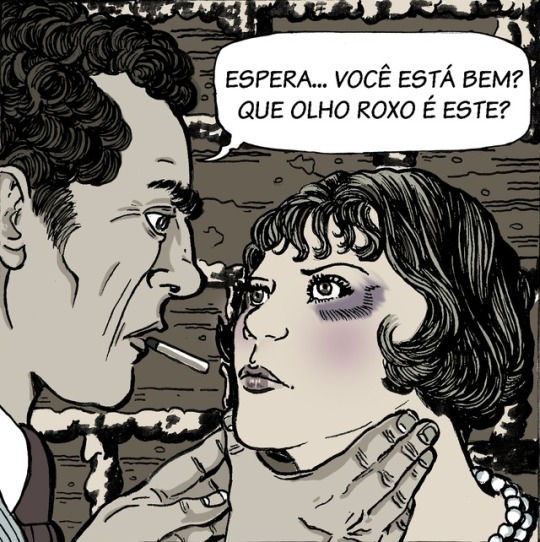
As sombras de Roberta Cirne
Uma das poucas representantes da nona arte em Pernambuco é Roberta Cirne, roteirista e desenhista das HQs de terror Sombras do Recife, publicadas no site homônimo. Além de cuidar de toda a parte literária e do design, a quadrinista também faz um resgate histórico da cidade. “A pesquisa que eu estou fazendo com os quadrinhos já existe há 19 anos, mas nunca consegui publicá-los por meios tradicionais”, declara, ao mencionar que a internet teve papel fundamental no seu trabalho. “Tudo o que produzi foi lançado online. Isso fez com que o projeto chegasse a todo Brasil, de um jeito que ainda me surpreende”, afirma. Atualmente, Roberta se dedica inteiramente aos quadrinhos, mas a trajetória foi longa para isso. “Me formei como arte-educadora e passei a dar aulas para poder me sustentar, mas sempre quis ser dona do meu próprio projeto. Hoje, não leciono mais, graças ao poder que a internet teve na minha carreira”.
Ainda conforme a Roberta, a ideia de criar a HQ surgiu em 1998. A princípio, ela havia pensado em fazer um quadrinho misturando cultura local com vampiros, pois já tinha criado alguns personagens e histórias nesta linha de terror mais globalizado. “Aos poucos fui refinando a história, à medida que lia mais sobre os usos e costumes da cidade, monumentos demolidos e desaparecidos, roupas, personagens pitorescos, doces, usos e costumes, coisas que s�� Recife tem”, contou, comentando que o material de referência provém de reportagens de jornais, livros encontrados em sebos, fotos e arquivos que ela foi juntando ao longo dos anos. “Ainda tenho guardados os manuscritos desta época e a pesquisa histórica que fiz, pois se trata de material praticamente inédito na internet, de livros que nunca foram reeditados em dezenas de anos”.

Neste momento do projeto, Roberta está narrando como cada assombração surge, em suas distintas épocas: Boca de Ouro, em 1913; A Velha Branca e o Bode Vermelho, em 1885; Branca Dias, em 1598; Papa Figo, em meados de 1850 etc. E para criar essas histórias ambientadas no Recife do passado, a quadrinista tem como objeto de pesquisa mais de 100 fontes literárias, como as obras de Câmara Cascudo, Gilberto Freyre, Mário Sette, Pereira da Costa e Antônio Gonsalves de Mello. “O que eu quero adicionar à ideia dos quadrinhos é a presença de textos extras, ou glosas, que podem ser lidos juntos ou em separado, mas que aprofundam a experiência da HQ. Estes textos serão paradidáticos, e contarão a história da cidade”.
Atualmente, Roberta está publicando a HQ do Boca de Ouro, que é um condutor de bonde de burro no Recife de 1913 - período em que a cidade passava por reformas e mudanças em seu transporte urbano. Humilde e com os dentes estragados, ele sonha em ficar com a mulher que ama, que é casada. Quando o jogo do bicho chega na cidade, Boca de Ouro resolve entrar na dança. Ele torna-se o maior bicheiro de Recife, coloca uma dentadura de ouro e se casa com a mulher amada, após assassinar o marido dela. O que ele não sabe é que a história tomará um rumo inesperado e terrível. “Usei a lenda do Boca de Ouro, que aparece às pessoas nas ruas de Recife como uma espécie de zumbi, e aproveitei para passar pelas reformas da cidade em 1911/1913, a demolição do porto e a vida noturna dos cafés da Praça do Diário (surgimento do jogo do bicho e a boemia do início do séc. XX na capital pernambucana)”. A HQ tem 18 páginas.
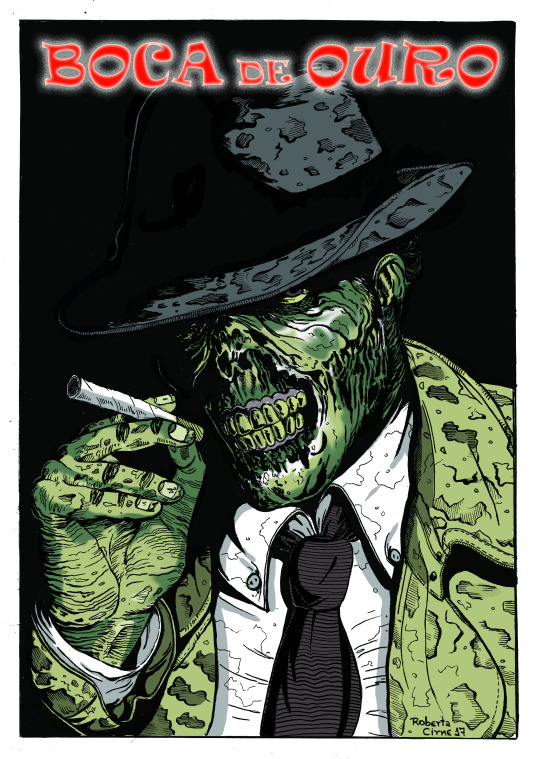
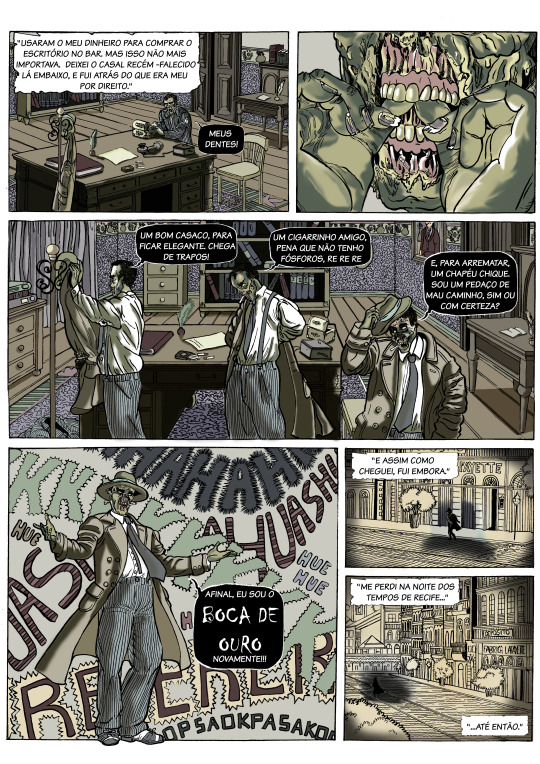
Recentemente, Roberta adaptou uma lenda nunca antes trabalhada e de pouco conhecimento geral: A Lenda do Palhaço do Coqueiro do Janga, que lida com o medo de palhaço. Um assunto bem atual, quando se leva em conta os ataques de palhaços nos Estados Unidos e produções cinematográficas como It: A Coisa. A HQ narra a história de um palhaço que, não conseguindo fazer ninguém rir, enlouquece e sai matando as pessoas que não o acham engraçado. “Cada HQ de assombração encaminha para uma junção, mas por enquanto vamos apresentando os personagens. É um universo em expansão, com muita coisa esperando para aparecer”, antecipou a quadrinista.
Confira a entrevista e conheça um pouco dos caminhos que levaram Roberta à Sombras:
1. Roberta, quando e em que circunstância o desenho entrou na sua vida?
Eu sempre adorei desenhar. Na minha casa, ninguém era artista, com exceção de uma tia por parte de pai. O nome dela era Alba, ela costumava fazer bonequinhas de papel desenhadas para mim. Com o tempo, eu mesma comecei a desenhar minhas próprias bonequinhas, e descobri sozinha, por observação, como projetar em perspectiva, usando distâncias de objetos. Mas foi esta minha tia, que admirei por toda a vida, que me mostrou os primeiros passos nas artes.
2. Na infância, você foi desestimulada ou estimulada a desenhar? Tinha acesso a quadrinhos quando criança? Se sim, de que tipo?
Assim que comecei a demonstrar interesse pela arte, meus pais deram o maior apoio. Incentivavam, davam materiais de arte para mim. As minhas melhores lembranças são as de receber, todo natal, livros (sempre adorei ler) e caixas de lápis de 48 cores da Faber-Castell, e papéis para desenho.
Quadrinhos, eu colecionava. Era fã das revistas da Luluzinha e do Bolinha, mas também adorava ler Almanaque Disney, principalmente as sagas da família pato, de Carl Barks. Tio Patinhas, os sobrinhos e as aventuras no Klondike e Escócia me faziam viajar. Eu mesma fazia minhas histórias em quadrinhos, também. Lembro que criei, aos 7 anos, uma HQ de uma menina que tinha uma boneca que ganhava vida. Fora isso, eu “quadrinizei” filmes que gostei, antes dos 10 anos. Tenho até hoje a HQ de Annie e de Peter Pan que fiz.
“Tive a sorte de minha mãe me apresentar aos heróis que ela costumava ler, como Mandrake e Fantasma”, disse Roberta.
3. Quais são as suas principais referências no desenho? O que pensa do fato de que havia poucos modelos de mulheres a serem seguidos nas HQs?
O mercado de quadrinhos sempre foi predominantemente masculino, então comecei pelo que eu gostava de ler. Como na época só tinha acesso aos “formatinhos” da Abril, li muito X-Men. As histórias de Chris Claremont ilustradas por Marc Silvestri me marcaram bastante, e quando comecei a fazer uma série de HQs com uma amiga, usava como modelo a seguir. Logo depois, me encantei com Alex Ross (Marvel Comics) e comecei a pintar em aquarela.
Um dos grandes problemas, na minha opinião, é que os quadrinhos no Brasil, antes da internet, eram bastante setorizados. Havia “quadrinhos para meninas” até certa idade, depois apenas super-heróis, o que focava no público adolescente masculino. Tive a sorte de minha mãe me apresentar aos heróis que ela costumava ler, como Mandrake e Fantasma. Depois ela passou a comprar pra mim umas edições de encalhe da Ebal. Do Superman, Batman e outros. Li muito X-Men, como já disse.
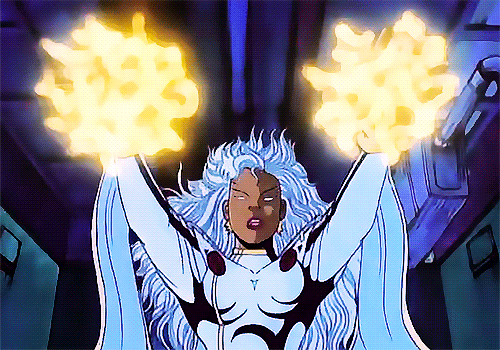
Em 1992, eu fazia HQs baseadas no RPG Vampiro: A Máscara, dos personagens que jogava em grupo de amigos. E também possuía, junto com outra amiga, um grupo de heróis de um universo distópico. Mas estas HQs eram apenas para nós mesmas e mais algumas pessoas que liam de “cobaias”. Não havia então nenhuma publicação de HQs com “temáticas femininas”. No Japão, há muito tempo já tínhamos as mangakás mulheres, e na Europa quadrinistas mulheres faziam parte do cenário franco-belga. Mas nada chegava de forma distribuída aqui. A falta de quadrinhos ditos “para garotas” de mais idade, não cultivava o hábito de leitura de HQs na maioria das meninas. Então, demorou bastante para que as (poucas) leitoras de quadrinhos de heróis começassem a produzir suas próprias histórias.
4. Existe uma discrepância entre o número de mulheres quadrinistas e a atenção que elas recebem? Cita alguma autora que você costuma ler e que acha que deveria ter mais destaque.
Com toda a certeza esta discrepância existe. Inclusive constatei que a grande maioria das quadrinistas mulheres ficam em casa, e compartilham seus trabalhos apenas com amigas. Que eu saiba, apenas umas três ou quatro (a maioria ilustradoras) estão atuando de forma visível no Recife. Eu sou uma das únicas que trabalha terror no Brasil, mas acredito que temos muito mais quadrinistas. Precisamos trazê-las para fora, mostrar seus trabalhos. Algumas desistem, abandonam os quadrinhos buscando caminhos menos áridos.
Uma das quadrinistas que mais admiro é a Marjane Satrapi, de Persépolis e Bordados. Seu trabalho é libertador, no que concerne aos direitos femininos.

5. Foi forçada a investir numa carreira séria antes de se tornar quadrinista? Ou chegou a fazer outra coisa antes por que não se conhecia o suficiente?
Entrei em crise várias vezes. Desenhar era “bonitinho” quando criança, mas se tornava um “hobby” pouco rentável, segundo meus pais, para se ter quando adulta. Tentei seguir o caminho da advocacia, mas terminei abandonando o curso de direito na UFPE pelo de artes plásticas (meu pai quase teve um treco hehe). Fazer quadrinhos era algo meio sofrido, por amor mesmo. Não dava dinheiro, a princípio. Fazia vários bicos e estágios na faculdade, principalmente porque casei e engravidei em seguida. Nosso núcleo familiar se formou neste redemoinho.
Dentro de um coletivo de quadrinhos, lançamos em 2006 (eu e um grupo de amigos) o primeiro álbum, chamado Passos Perdidos, História Desenhada, pela Sinagoga do Recife. Ganhamos o Troféu HQ Mix 2007 de maior contribuição para os quadrinhos nacionais. Fizemos juntos mais seis álbuns pelo MinC e Fundarpe, mas nenhum deles era roteirizado por mim. Tinha certa liberdade em criar as artes, mas queria mais. Os projetos culturais davam algum dinheiro, na época. Para sustentar a vida de forma regular, me formei como arte-educadora e dava aulas. Todo o conjunto das coisas não era o que eu queria fazer, na verdade. Queria ser dona de meu próprio projeto, e pesquisava sobre Recife desde 1998. Queria algo que me representasse mais.
Abandonei as HQs em 2010, para cuidar de meus pais nos seus últimos anos. Não me arrependo disso, pois esta parada me fez repensar muita coisa. Em 2015, voltei às HQs. A princípio, produzindo aos poucos, para mim mesma, e depois aumentei a produtividade. Atualmente, não leciono mais. Posso me manter, e me dedico 100% aos quadrinhos. São os meus quadrinhos, feitos exatamente do jeito que sempre quis. A internet teve este poder em minha carreira.
“O que falta para as mulheres entrarem de vez nos quadrinhos é a visibilidade”, opinou a quadrinista.
6. Você acha que está inserida num meio particularmente hostil? O que falta para que as mulheres possam ser propriamente incluídas e deixem de ser uma raridade no mercado editoral e nas indicações a prêmios de HQs?
Como meu trabalho é totalmente autoral, não há competitividade, como no caso do mercado americano, europeu ou oriental de quadrinhos. Há o estranhamento, ainda nos dias de hoje, de estar em um meio predominantemente masculino, sim. As mesmas perguntas que me faziam em entrevistas em 93, fazem hoje. Mas está um pouco diferente. Já não é tão fechado. A grande maioria dos produtores de quadrinhos de Recife eu conheço há anos, como é o caso da PADA (Produtores, Artistas e Desenhistas Associados), Eduardo Schloesser, Leonardo Santana, Milton Estevam, entre outros. São amigos que respeito e que me respeitam, nesta caminhada.
O que falta para as mulheres entrarem de vez nos quadrinhos é a visibilidade, como já disse. Quem faz, precisa lançar na mídia seu produto, sua ilustração, tira, série. A internet é um excelente meio. Divulgar, criar blogs, sites, jogar ao público seus projetos.
7. Qual a sensação de estar contrapondo estereótipos e rompendo tabus com o seu trabalho? Fala um pouco também sobre Sombras do Recife.
A sensação é a melhor que já tive na vida. Sei que sou uma das únicas a trabalhar com quadrinhos, e possivelmente a contar nos dedos da mão direita que trabalha com terror. Estou quebrando este paradigma, e agradando ao público tanto feminino, quanto masculino. Não existe nada melhor que fazer exatamente o que você quer, e receber aprovação dos leitores e fãs do site.
A pesquisa que estou trazendo com as HQs de Sombras do Recife já existe há 19 anos, porém nunca consegui publicar pelos meios tradicionais. Trabalhei em Passos Perdidos, Afro HQ e Heróis da Restauração em parceria com roteiristas e historiadores, então basicamente eu fiz apenas a parte gráfica dos quadrinhos. Já as histórias do Sombras são roteirizadas e desenhadas por mim, então estou cuidando de toda a parte literária, histórica e de design. Demora cerca de dois meses para transformar o roteiro já existente em rascunhos, fazer a pesquisa de vestuário, móveis e ruas (basicamente pegando ruas que não existem mais e resgatando para a topografia da cidade atual). Além do desenho, arte-final e balonagem. Todo o site é criado, mantido e organizado apenas por mim, que ainda cuido da parte de design e SEO.
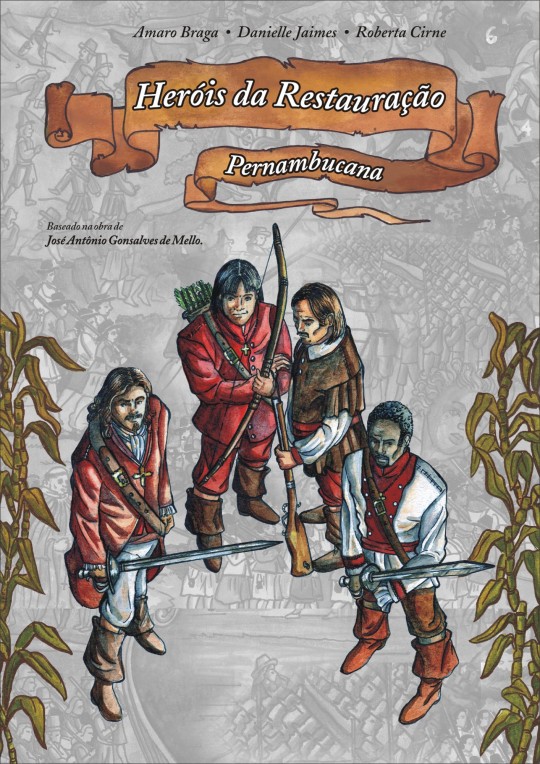
Temos, na época atual, de saber lidar com tudo, e eu sou bastante curiosa para pesquisar e criar em tudo o que busco. Sempre gostei muito da temática de horror, desde criança, e já escrevia contos de suspense com nove anos. Terror sempre foi a minha área. História da cidade e terror foram escolhas naturais, e poder apresentar e representar graficamente a cidade nesta forma é algo que sempre tive em mente, contar coisas que muitos recifenses desconhecem, passando pelas ruas, pontes, praças, sem desconfiar de toda a história que elas carregam. Não é apenas assombração e o susto pelo susto, é incorporar o medo ao ambiente da cidade, mostrando em cenários ruas que não mais existem, costumes que entraram em desuso. As assombrações do Recife foram por muito tempo pouco exploradas, e acredito que este projeto tem um potencial de resgate histórico imenso.
8. Já passou por alguma situação constrangedora simplesmente pelo fato de ser mulher e quadrinista? Foi subestimada de alguma forma?
Como mulher, já passei por inúmeras situações constrangedoras. Como quadrinista, apenas do ponto de vista do trabalho em si. Certa vez, tentei entrar no mercado americano, mas meu traço foi considerado fraco para dar a energia que os super-heróis precisavam. Pediram que modificasse meu traço, e então, preferi desistir deste mercado. Fui subestimada por ter abandonado a área por um tempo, mas estou cada vez mais disposta a lutar e mostrar que estou aqui para ficar.
9. Qual o papel da internet em relação ao seu trabalho? O que seria dele hoje em dia se dependesse da indústria?
A internet teve papel fundamental. Para começar, tudo o que produzi para o Sombras do Recife foi lançado na net. Isso fez com que o projeto chegasse a todo País, de um jeito que ainda me surpreende. Se ficasse apenas na dependência da indústria, do quadrinho tradicional impresso, talvez não tivesse toda esta repercussão. Estamos para lançar a revista agora em dezembro por apoio da Prefeitura do Recife e Secretaria de Turismo da Cidade, mas o alcance do site é de milhares de pessoas. A revista, pode atingir 1000, 2000 leitores. Por isso, reitero o valor de se lançar na mídia online. Tudo que estou conseguindo começou com a publicação na internet.
10. Busca inserir temáticas feministas nas suas histórias ou tenta desconstruir suas personagens quando as cria? Se sim, acha que faz algum efeito, que está se fazendo ouvida?
Gosto de trabalhar com anti-heróis, e anti-heroínas. Não tenho pena de maltratar os personagens e acredito que tudo é válido para criar uma boa história. Minhas personagens são fortes, às vezes usam de meios pouco honestos, como no caso da Guilhermina, de Boca de Ouro. Não a pintei com cores suaves, pois ela é manipuladora. Personagens densos são mais similares às pessoas, e isso aumenta a empatia do leitor pela trilha de evolução do personagem, seja do sexo feminino ou não.

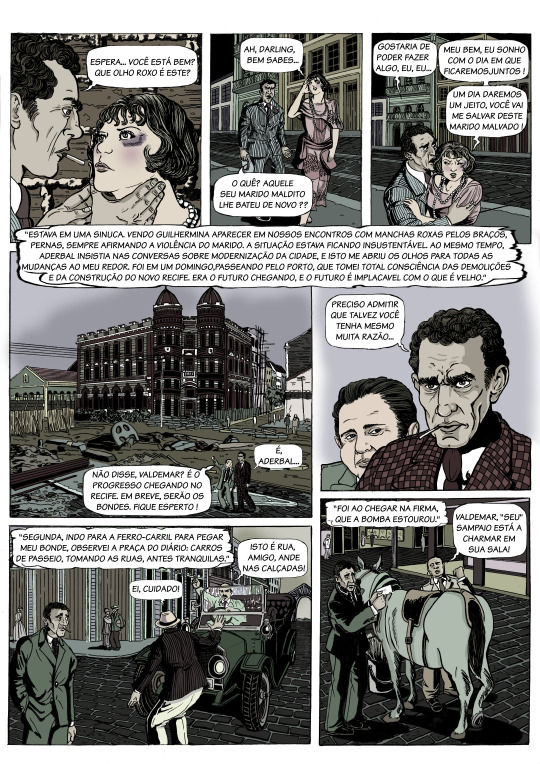
0 notes